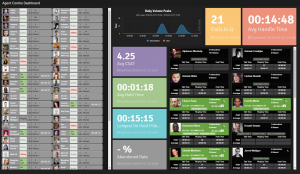— July 2, 2019
You just received a hot lead email address from marketing. It’s time for you to send a compelling sales email. But how do you effectively start a conversation that will eventually help you close the deal? After all, the average recipient deletes 48 percent of the daily emails they receive. Your emails need to stand out and encourage the recipient to interact.
Create a sales email that captures the reader’s attention and has a good chance of leading to a sale with the following examples and tips.
5 engaging sales email examples for you to replicate
Before jumping into examples, let’s take a look at what constitutes a well-written sales email. The best sales email is focused on the customer’s time and needs:
- Write engaging subject lines. Thirty-five percent of email recipients open an email based solely on the subject line. Compose subject lines that ask questions, present data-based insights, or speak to a pain point.
- Make opening lines non-generic. Your email subject line may have gotten you past the front door, but now your opening line needs to encourage the recipient to keep reading. Open with lines such as “I loved your blog post…” or “I was excited to hear about…” Skip the generic “Hi, my name is…”
- Keep the body of the email short and sweet. Boomerang found that “emails between 50 and 125 words had the best response rates at just above 50%.” Cut the excess language and get to your point. Also, write your emails on a third-grade reading level.
- Avoid talking about yourself. An email recipient wants to know what you can do for them, not about how wonderful you and your company are. Research your contact on their website and social media to learn everything you can about their needs.
- Include a clear call-to-action and next steps. Don’t make the reader guess what they should do next. Do you want to present a demo? Discuss your offering over a quick call? Provide direction for the reader to keep the conversation going.
Keeping these best practices in mind, let’s analyze five sales email examples and why they work.
1. An experiment with 1,000 cold emails reveals short subject lines win
The average office worker receives hundreds of emails a day. The sales email subject line is your opportunity to stand out and prove that your email is worth opening. Shane Snow, author and co-founder of The Hatch Institute and Contently, and Jon Youshaei, Instagram’s Product Market Manager performed an experiment to determine what type of subject line and sales email would get a response from busy executives.
First, they gathered email addresses of 1,000 of the busiest businesspeople in America, including 500 C- and VP-level executives from the Fortune 500, and 500 C-level execs from the Inc 500. Then, they wrote ten versions of a simple email asking for the executives’ opinions on cold emails. Below is one of the most successful versions:
Subject Line: Quick Question
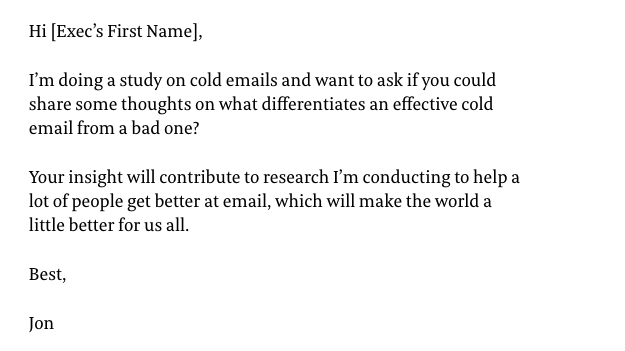
The two subject lines they tested were “Quick Question” (51% open rate) and “15 Second Question for Research on Annoying Emails”(48% open rate). Although the open rate was somewhat similar, 66.7% of total replies were in response to the subject line “Quick Question.”
Why it’s effective: The subject line is short and direct (two elements of a good subject line). Granted, only 12 out of 700 responded, so it’s difficult to tell how much impact this one particular subject line had, but both Snow and Youshaei agreed that personalization is key to sales emails. Even adding a name to the subject line can drastically improve the response rate.
2. A personalized intro from Moz doubled their reply rate
Along with the subject line, the most common sales email element that sales reps get wrong is the opening line. For example, using an opening line such as “My name is Brad” sounds like it’s from a boring template and can affect your reply rate. Marketing and marketing analytics software company Moz needed a higher reply rate for their guest blogger outreach. Out of 20-50 emails per week, the team was only receiving 2-4 positive replies.
Here is the company’s initial script:
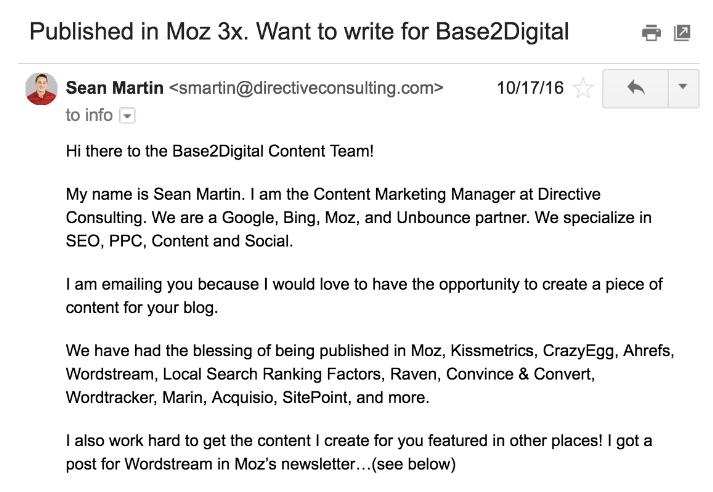
The above example’s introductory line is not very personal and is also a bland way to introduce the sender and company. Moz tried a more creative variation of the same message.
Thanks to the new email template, Moz’s reply rate increased from 8% to 16%. The engaging header with the sender’s picture and blurb replaces the original introduction.
Why it’s effective: The opening line is personal and makes use of the words “you” and “your” (more effective than “I” and “we”). It also gets straight to the point: “I am emailing you because I would love the opportunity to create a piece of content for your blog.” The line invites the reader to go further if they want to learn more about the content opportunity.
3. LeadFuze’s cold email formula grew revenue
Especially in today’s media-saturated world, our attention spans are very short. We’re also busy and don’t have time to read lengthy emails that take too long to get to the point. According to LeadFuze’s Founder Justin McGill, a great approach to emails is the “QVC Formula:” Ask a question, present your value proposition, and then include a clear call-to-action such as “Interested in a demo?”
The body of LeadFuze’s sales email includes all of these variables. It attracts the reader’s attention without drowning them in text.
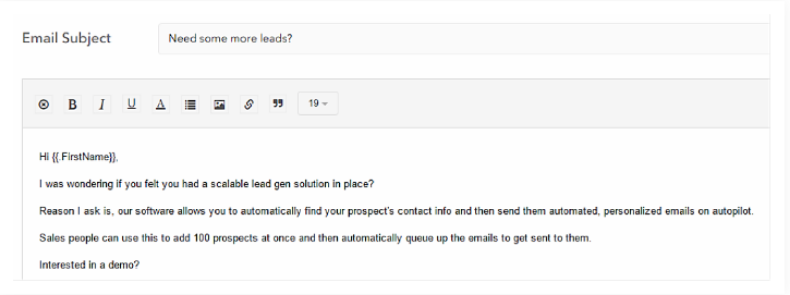
LeadFuze’s cold email approach is working: In just one year, the company used cold email to grow company revenue to $ 30K per month.
Why it’s effective: The body of the email is less than 70 words. It asks a quick question, presents what pain point LeadFuze solves, and then asks for a meeting — personal, short, and effective. Two other great elements of this email? The subject line asks a simple, compelling question: “Need some more leads?” It also includes a P.S. at the end “If you aren’t the right person to speak about this, let me know. Also, if you’d rather I not follow up with you – you can let me know that too!” This line alleviates pressure on the reader.
4. Jake Jorgovan’s personalized sales emails generated $ 12K
A good rule of thumb for making any sale? It’s not about you — it’s about the customer. Creative strategist Jake Jorgovan took this lesson to heart and created personalized cold emails to send to leads (rather than sending batches of generic emails). His approach worked. The following email example generated $ 4,250 for Jorgovan.
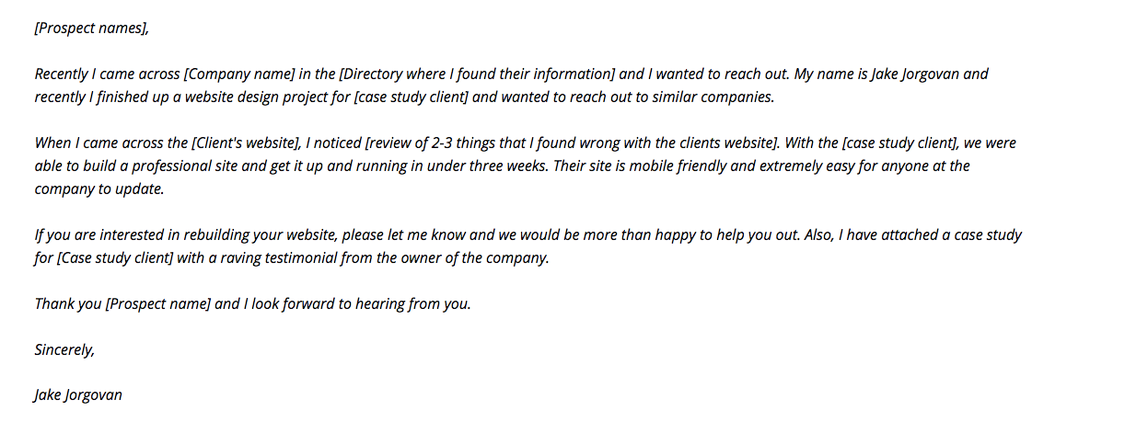
Why it’s effective: Notice how the second paragraph of the email shows that Jorgovan is already familiar with the recipient’s needs. Before sending his emails, Jorgovan researched his target market and made sure the material he was sending was relevant to the recipient. Review your target persona before sending your cold sales emails. This will help you create personalized emails that speak to the reader’s pain point.
Another tactic that Jorgovan used was include a relevant case study. The case study backed up the claims he was making about his company. His advice? Make sure your case study is relevant to the prospects you are e-mailing. Jorgovan closed over $ 12K worth of deals based solely on this cold email approach.
5. Crazy Eye Marketing’s calls to action increased reply rate
A pushy sales email (e.g., Buy my product!) is a great way to end up in the Trash folder. Crazy Eye Marketing experimented with the opposite — a non-pushy CTA. The company ran a cold e-mail campaign for a small mobile app company. Working with 4,897 email addresses, the company composed five different email series.
The most effective series? A three email sequence with clear CTAs. The first email in the series asked for only fifteen minutes of the reader’s time.
Email #1:
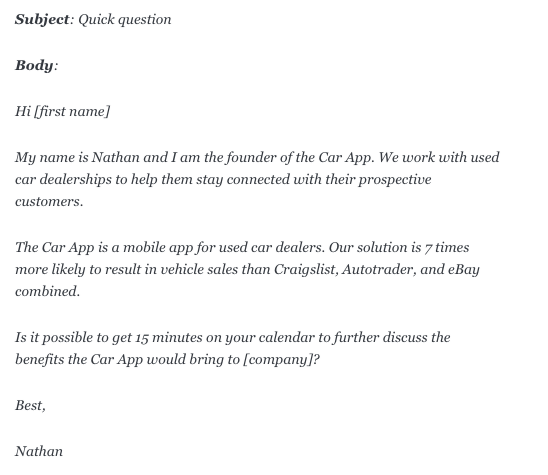
Here are the final results of the email campaign. Email #1 received a reply rate of 8%. The two additional follow-up emails received a similar reply rate:

Why it’s effective: The reader knows exactly what to do at the end of the email (say yes or no to a fifteen-minute meeting). And who doesn’t have time for fifteen minutes?
Another great lesson from this case study is to keep trying even if you don’t receive a response back the first try. Forty-four percent of sales reps give up after the first follow up even though 80% of sales require at least four follow-ups — reach out to your contact more than once!
Use these sales email examples to create your own
With these sales email examples as your guide, take that email address from marketing and send a compelling email to the hot lead. Also, use your CRM to track the lead’s response and try integrations like Mailchimp to test subject lines, content, and CTAs. You then set yourself up for success for the next lead email.
Sales emails don’t have to be difficult — keep the customer at the forefront of every conversation and prove that you value the recipient’s time and business.
Digital & Social Articles on Business 2 Community
(82)



